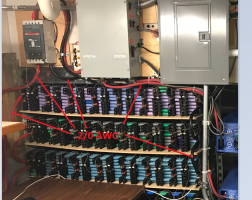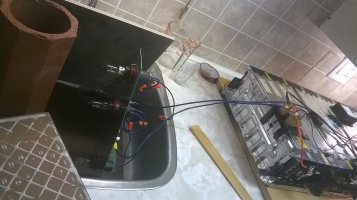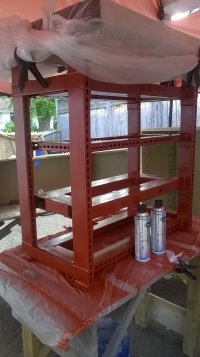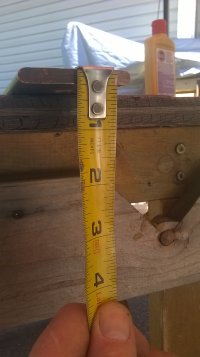Charger arrived. Looks good, but I am still waiting for the postal service to deliver the BMS (went with REC) so I can test out charging. Planning to use 4x 12V headlight bulbs in series for the drain test.
I'm wondering about cabling now and am looking for advice. I'm likely to go with 2/0 for my 30+ parallel connections, ea. one ~8" long. Trying to decide what kind of cabling will be best. I read through a few forums on cabling and seems like some prefer marine grade tinned copper cabling, while others prefer welding cable. I bought 1 ft. of this stuff, flex-a-prene welding cable 2/0, to see what it feels like, and it seems good for my purposes - no UV exposure, not marine environment (although it will be in a shed). I'm also trying to figure out what I will need for inspection - does it generally have to be UL rated? - maybe best to check with AHJ about this detail? Since I'm going to be fabricating so many cables, I am trying to avoid the situation where they ask me to redo.
Input appreciated.
[EDIT May 16: Just reading through the 2018 Canadian Electric Code (CEC) and found this restriction on cabling: "flexible building-wire-type cables are available and are suitable for this use [i.e. for connecting to battery terminals - I believe both for intra-battery connections and for battery to inverter connections]. This Code does not permit welding and battery cables to be used for this purpose" (CEC 2018, Appendix B, Rule 64-810, p. 709). So, "flexible building wire type cables" it is.
I'm wondering about cabling now and am looking for advice. I'm likely to go with 2/0 for my 30+ parallel connections, ea. one ~8" long. Trying to decide what kind of cabling will be best. I read through a few forums on cabling and seems like some prefer marine grade tinned copper cabling, while others prefer welding cable. I bought 1 ft. of this stuff, flex-a-prene welding cable 2/0, to see what it feels like, and it seems good for my purposes - no UV exposure, not marine environment (although it will be in a shed). I'm also trying to figure out what I will need for inspection - does it generally have to be UL rated? - maybe best to check with AHJ about this detail? Since I'm going to be fabricating so many cables, I am trying to avoid the situation where they ask me to redo.
Input appreciated.
[EDIT May 16: Just reading through the 2018 Canadian Electric Code (CEC) and found this restriction on cabling: "flexible building-wire-type cables are available and are suitable for this use [i.e. for connecting to battery terminals - I believe both for intra-battery connections and for battery to inverter connections]. This Code does not permit welding and battery cables to be used for this purpose" (CEC 2018, Appendix B, Rule 64-810, p. 709). So, "flexible building wire type cables" it is.
Last edited:




![WP_20140525_08_13_52_Pro[1].jpg WP_20140525_08_13_52_Pro[1].jpg](https://secondlifestorage.com/data/attachments/23/23689-dcb20ee9ba4adab4305482827a105e92.jpg)
![WP_20140525_08_14_13_Pro[1].jpg WP_20140525_08_14_13_Pro[1].jpg](https://secondlifestorage.com/data/attachments/23/23690-40d93b86ad411c2318b53e3f078dc678.jpg)
![WP_20140525_08_16_09_Pro[1].jpg WP_20140525_08_16_09_Pro[1].jpg](https://secondlifestorage.com/data/attachments/23/23691-479fbe950ad040534d8183674dccfaff.jpg)









